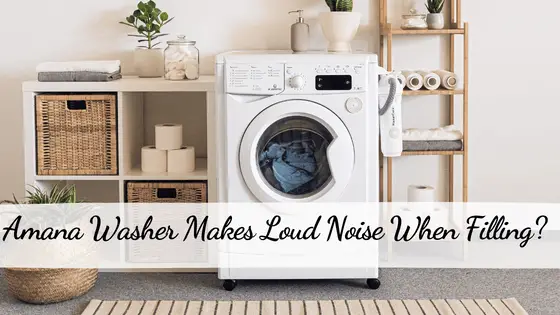Having a washing machine makes life a lot easier whether you have kids or a bachelor with other stuff to do.
These machines can also be overwhelming to diagnose if noises and electrical problems arise suddenly.
The best washing machines offer value for money and they also require adequate maintenance procedures.
When the Amana washer makes loud noise when filling, it is likely to be a problem with hoses.
Other factors like loads, loose parts, dirt on screens or an aging machine, problem with spluch cam, could be at play too.
The Amana washer is considered a modern-day type of washing machine, meaning it boasts plenty of electrical and hardware components.
Let’s examine what could be causing the Amana washer to make noises while filling.
Amana Washer Makes Loud Noise When Filling?- Causes and Solutions
Cold Water Valve
Most washing machine owners prefer using cold water to wash and rinse clothes as opposed to hot water.
The cold water inlets can sometimes get clogged up or simply worn out and begin to malfunction.
When this happens, cold water will drip slowly into the drum, usually with a squealing sound.
It can also turn out quite ugly if it continues to fill in and never stops.
It means flooding your basement is very possible.
Turning the machine to diagnostic mode helps solve this issue.
Simply turn the dial in the appropriate directions to switch to testing the cold water valve.
These procedures can be found in the user manual.
Have a professional open up the valve inlets to remove clogging or replace valves if necessary.
Hoses
Check to see if the hoses are inserted correctly into the machine and on the water valves.
The most annoying noises start from the outside of the washer.
If the Amana washer makes loud noise when filling, it could be an issue of the fitting.
The water hoses need to be inserted fully into the drain pipes and secured properly onto the machine.
It is reasonable to assume there will be noise if water is gushing through the hoses and they are loose.
Anything that is not secured should be tightened.
This can include the use of tie strips to keep hoses and wires in place.
Unstable
If the machine is unstable, it will make noises while bringing in water and while spinning.
Part of the water intake happens at the beginning but also during wash cycles.
If the machine is unstable, it will make noises before and after a spin.
This is because the spin cycles put the hoses and inlets out of place.
Imagine a machine with tightened valves and inlets.
If the machine is unstable, however, these inlets and hoses get loose meaning water is either getting pushed harder to go through or is not flowing through at all.
The instability causes shakes, which can also move other parts out of place.
Using pallets can help with stability although most machines can be adjusted for height and stability.
Dirt
Hoses and drainage pipes bring in and remove dirt consistently, which is not always cleared properly.
As you use the machine daily, the amount of lint and dirt that accumulates grows.
This lint and dirt won’t cause mayhem within the machine but it can create squealing and squeaking sounds.
The reason here is obvious. Less water is flowing through the pipes than should be and as the machine pushes the water through, it struggles.
The noise emanating through the pipes at this point won’t be loud, but it will be annoying.
It is also a sign that you need to fix it to avoid overflowing water.
A pipe experiencing forced pressure can burst or at the very least, push water through when it is not necessary.
Clean the pipes with a wire hanger or remove them entirely to get rid of dirt and lint that might be compromising flow.
Water Pump
The water pump might be aging and needs replacing, or it could be clogged up too.
This is located on the front side of the machine, underneath the front cover.
If the water pump is struggling to bring in water, you can remove it and clean it.
Once you reinstall it and the problem persists, seek other alternatives.
The pump might need to be replaced entirely and not just a cleaning job.
A water pump needs professionals to replace it but not necessarily to diagnose it.
Seek professional assistance when buying a new one to avoid buying counterfeit parts.
A replacement water pump needs to be genuine to avoid replacing it again soon.
Turned Up
The water pressure might be turned up too high and thus is causing noises.
When the tap brings in water, it should be flowing slowly and smoothly into the machine.
Some taps are connected to direct sources of water, i.e. the main water supply.
This brings in water at very high pressures, usually ideal for carwashes and such.
However, with a washing machine, it is important to have lower pressure.
Turn down the water supply pressure on the tap supplying water to the machine.
If the Amana washer makes loud noises when filling, this noise can be lessened with adequate pressure.
Remember, the lower the pressure of water the less likely it is that pipes will burst or water will overflow – and with this comes less noise.
High Pressures
The machine might need an overhaul if water is entering too quickly.
Unlike the above-mentioned problem due to taps turned up too high, the water pressure inside the machine can also be a problem.
The noise you hear might not be on the exterior and could be water gushing in faster than normal.
This needs you to diagnose the problem without any clothes in the washer.
Simply switch to an appropriate cycle and leave the lid open if possible.
This should be possible on a top loader, or you might need to go to diagnostic mode.
If indeed water is seeping in too quickly, you might have to reseal the outlets inside and seek help from a professional.
Interference
Most top loaders have fewer components involved when water is trickling inside.
This means once the water reaches adequate amounts, or even before, water and other stuff can be added without too much fuss.
Front-loaders have inlets for water, soap, and softeners.
These can get clogged up with dirt but worse yet, there could be components or parts that are loose.
Open the trays and leave them open when water is trickling in and keep soap and softeners away for the time being.
If indeed this is where the problem lies, it will be easy to fix.
Shoddy repairs
If your machine previously had to be fixed there could a chance that parts are missing, or were never tightened.
As you run water through the machine, it might be harder to diagnose precisely where the problem is.
It requires the help of a technician to pinpoint the problem, or it will remain a headache.
When replacing parts, especially hoses, there will be debris or remnants from cut-off wires and others.
These are hard to sort when rushing to replace parts and move to wash clothes.
It is almost impossible to know which bits ended up where meaning opening up the entire unit will be necessary.
Splutch Cam
This cam makes for smoother pumping of water and controls cycles too.
Some owners experience a loud noise when the machine is filling up with water, yet no noise when the unit is in a spin or rinse cycle.
This is a particularly tough part to remove and replace.
It requires opening the bottom of the sides of the washing machine to reveal pulleys and the motor.
The cam can be removed after the belt is loosened and removed.
Also, the machine needs to be turned off completely before undertaking this step.
Not Filling
Did it ever occur to you that it is indeed not filling?
When you mention the Amana washer makes a loud noise when filling, it might not be filling at all.
Some machines will make an annoyingly high-pitched sound as they struggle to draw water in, to no avail.
If water is not entering at all yet the machine is actively trying to fill the drum, there will be noises.
Check to see that an adequate water supply is available and the washer isn’t running for no reason.
Failure to note this problem can lead to more noise and possible damage.
Dirt on Screens
The hoses have metal or plastic screens that hold back dirt from running through.
These are easy to clean using a toothbrush or other plastic components.
Although this may not cause significantly loud noises, such dirt can cause a whistling sound which can also become annoying.
Cleaning out these screens on hoses is a simple enough task. It does not require expert consultation.
Bottom Line
With the information above, your next washing machine cycle should be a breeze.
It takes a few tweaks here if Amana washer makes noise when filling and there to get the load in and out and ready for the next cycle with less noise.
However, major noises can be a sign of a dying machine.
Be sure to get a professional to check out such noises before they become a headache.
Sources:
https://www.youtube.com/watch?v=qq37YBKr3q8
Related Articles:
Amana Washer Lid Lock Flashing?


